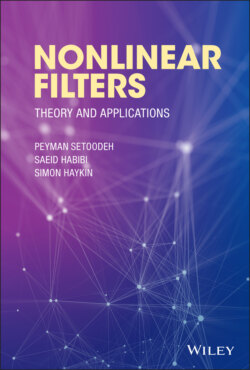Читать книгу Nonlinear Filters - Simon Haykin - Страница 33
3 Observers 3.1 Introduction
ОглавлениеState of a system refers to the minimum amount of information, which is required at the current time instant to uniquely describe the dynamic behavior of the system in the future, given the inputs and parameters. Parameters reflect the physical properties used in a model as a description of the system under study. Inputs or actions are manipulated variables that act on the dynamic system as forcing functions. Outputs or observations are variables that can be directly measured. In many practical situations, the full state of a dynamic system cannot be directly measured. Hence, the current state of the system must be reconstructed from the known inputs and the measured outputs. State estimation is deployed as a process to determine the state from inputs and outputs given a dynamic model of the system. For linear systems, reconstruction of system state can be performed by deploying the well‐established optimal linear estimation theory. However, for nonlinear systems, we need to settle for sub‐optimal methods, which are computationally tractable and can be implemented in real‐time applications. Such methods rely on simplifications of or approximations to the underlying nonlinear system in the presence of uncertainty [9]. In this chapter, starting from deterministic linear state estimation, the stage will be set for nonlinear methods, and then, unknown inputs such as faults and attacks will be discussed. Since state estimators are usually implemented using digital processors, emphasis will be put on methods in which measurements are available at discrete sampling times. There are two classes of observers regarding the order of the observer as a dynamic system and the order of the system under study whose state is to be estimated:
Full‐order observers: The order of the observer is equal to the order of the main system.
Reduced‐order observers: The order of the observer is less than the order of the main system.
In the following, the symbol “ ” denotes the estimated variable. Since such variable is determined based on the measured outputs, for clarification, two time indices will be used: one for the estimate and the other for the measurement. For discrete‐time systems, denotes the estimate of the state, , at time instant , given output measurements up to time instant . Similarly, for continuous‐time systems, denotes the estimate of the state, , at time instant , given output measurements up to time instant . The estimate is
a smoothed state estimate, if ,
a filtered state estimate, if , and
a predicted state estimate, if .
For control applications, usually the control law uses the filtered state estimate, which is the current estimate based on all available measurements. The predicted estimate relies on the state transition model to extrapolate the filtered estimate into the future. Such estimates are usually used for computing the objective or cost function in model predictive control. Smoothed estimates are computed in an offline manner based on both past and future measurements. They provide a more accurate estimate than the filtered ones. They are usually used for process analysis and diagnosis [9].
